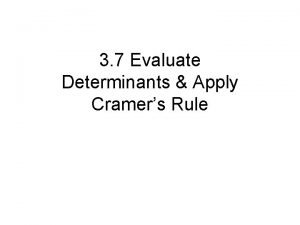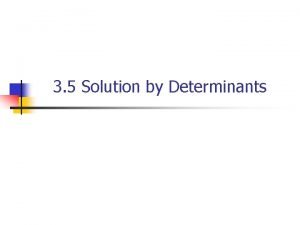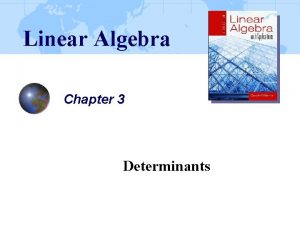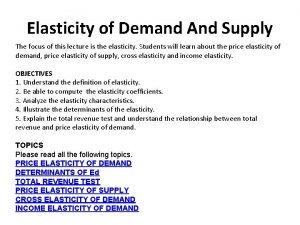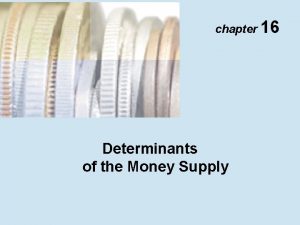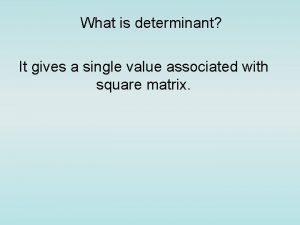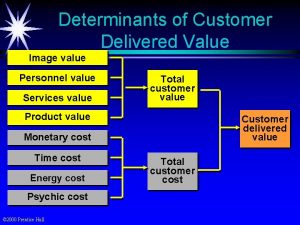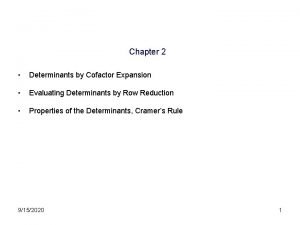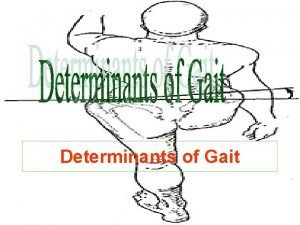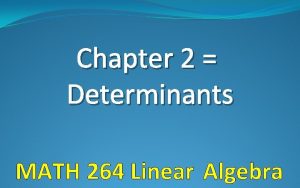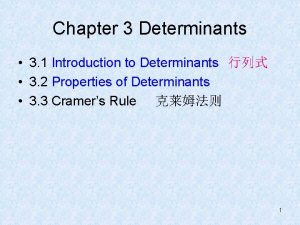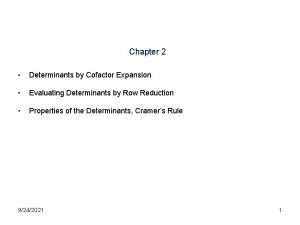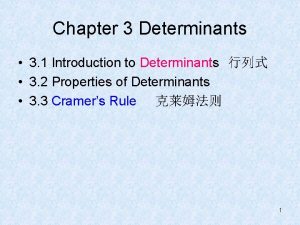Sec 3 6 Determinants Sec 3 6 Determinants



![Sec 3. 6 Determinants Def: Minors Let A =[aij] be an nxn matrix. The Sec 3. 6 Determinants Def: Minors Let A =[aij] be an nxn matrix. The](https://slidetodoc.com/presentation_image_h/206547070eeb4db5ae0bbc7ef0b472b6/image-4.jpg)
![Sec 3. 6 Determinants Def: Cofactors Let A =[aij] be an nxn matrix. The Sec 3. 6 Determinants Def: Cofactors Let A =[aij] be an nxn matrix. The](https://slidetodoc.com/presentation_image_h/206547070eeb4db5ae0bbc7ef0b472b6/image-5.jpg)


















![Adjoint matrix Def: Cofactor matrix Let A =[aij] be an nxn matrix. The cofactor Adjoint matrix Def: Cofactor matrix Let A =[aij] be an nxn matrix. The cofactor](https://slidetodoc.com/presentation_image_h/206547070eeb4db5ae0bbc7ef0b472b6/image-24.jpg)



- Slides: 27

Sec 3. 6 Determinants

Sec 3. 6 Determinants Recall from section 3. 5 : TH 2: the invers of 2 x 2 matrix

Sec 3. 6 Determinants 2 x 2 matrix Evaluate the determinant of How to compute the Higher-order determinants
![Sec 3 6 Determinants Def Minors Let A aij be an nxn matrix The Sec 3. 6 Determinants Def: Minors Let A =[aij] be an nxn matrix. The](https://slidetodoc.com/presentation_image_h/206547070eeb4db5ae0bbc7ef0b472b6/image-4.jpg)
Sec 3. 6 Determinants Def: Minors Let A =[aij] be an nxn matrix. The ijth minor of A ( or the minor of aij) is the determinant Mij of the (n-1)x(n-1) submatrix after you delete the ith row and the jth column of A. Find
![Sec 3 6 Determinants Def Cofactors Let A aij be an nxn matrix The Sec 3. 6 Determinants Def: Cofactors Let A =[aij] be an nxn matrix. The](https://slidetodoc.com/presentation_image_h/206547070eeb4db5ae0bbc7ef0b472b6/image-5.jpg)
Sec 3. 6 Determinants Def: Cofactors Let A =[aij] be an nxn matrix. The ijth cofactor of A ( or the cofactor of aij) is defined to be Find signs

Sec 3. 6 Determinants 3 x 3 matrix signs Find det A

Sec 3. 6 Determinants The cofactor expansion of det A along the first row of A Note: q 3 x 3 determinant q 4 x 4 determinant q 5 x 5 determinant q nxn determinant expressed in terms of three 2 x 2 determinants four 3 x 3 determinants five 4 x 4 determinants n determinants of size (n-1)x(n-1)

Sec 3. 6 Determinants nxn matrix We multiply each element by its cofactor ( in the first row) Also we can choose any row or column Th 1: the det of an nxn matrix can be obtained by expansion along any row or column. i-th row j-th column

Row and Column Properties Prop 1: interchanging two rows (or columns)

Row and Column Properties Prop 2: two rows (or columns) are identical

Row and Column Properties Prop 3: (k) i-th row + j-th row (k) i-th col + j-th col

Row and Column Properties Prop 4: (k) i-th row (k) i-th col

Row and Column Properties Prop 5: i-th row B = i-th row A 1 + i-th row A 2 Prop 5: i-th col B = i-th col A 1 + i-th col A 2

Row and Column Properties Either upper or lower Zeros below main diagonal Prop 6: Zeros above main diagonal det( triangular ) = product of diagonal

Row and Column Properties

Transpose Prop 6: det( matrix ) = det( transpose)

Transpose

Determinant and invertibility THM 2: The nxn matrix A is invertible det. A = 0

Theorem 7: (p 193) row equivalent Every n-vector b Ax = b has unique sol Every n-vector b is a product of elementary matrices Ax = b is consistent The system All statements are equivalent Ax = 0 has only the trivial sol nonsingular

Determinant and inevitability THM 2: Note: det ( A B ) = det A * det B Proof: Example: compute

Cramer’s Rule (solve linear system) Solve the system

Sec 3. 6 Determinants Cramer’s Rule (solve linear system) Solve the system

Cramer’s Rule (solve linear system) Use cramer’s rule to solve the system
![Adjoint matrix Def Cofactor matrix Let A aij be an nxn matrix The cofactor Adjoint matrix Def: Cofactor matrix Let A =[aij] be an nxn matrix. The cofactor](https://slidetodoc.com/presentation_image_h/206547070eeb4db5ae0bbc7ef0b472b6/image-24.jpg)
Adjoint matrix Def: Cofactor matrix Let A =[aij] be an nxn matrix. The cofactor matrix = [Aij] Find the cofactor matrix Def: Adjoint matrix of A signs Find the adjoint matrix

Another method to find the inverse How to find the inverse of a matrix Thm 2: The inverse of A Find the inverse of A

Computational Efficiency The amount of labor required to compute a numerical calculation is measured by the number of arithmetical operations it involves Goal: let us count just the number of multiplications required to evaluate an nxn determinant using cofactor expansion 2 x 2: 2 multiplications 3 x 3: three 2 x 2 determinants 3 x 2= 6 multiplications 4 x 4: four 3 x 3 determinants 4 x 3 x 2= 24 multiplications 5 x 5: four 3 x 3 determinants 4 x 3 x 2= 24 multiplications --------------nxn: n (n-1)x(n-1) determinants nx…x 3 x 2= n! multiplications

Computational Efficiency Goal: let us count just the number of multiplications required to evaluate an nxn determinant using cofactor expansion nxn: determinants requires n! multiplications a typical 1998 desktop computer , using MATLAB and performing only 40 million operations per second To evaluate a determinant of a 15 x 15 matrix using cofactor expansion requires a supercomputer capable of a billion operations per seconds To evaluate a detrminant of a 25 x 25 matrix using cofactor expansion requires
 Carrier selection determinants
Carrier selection determinants Social determinants of personality
Social determinants of personality Chapter 6 section 1 combining supply and demand answers
Chapter 6 section 1 combining supply and demand answers Determinants of consumption
Determinants of consumption Cramers rule
Cramers rule Determinants socials de la salut
Determinants socials de la salut Kramer formulasi
Kramer formulasi Determinant multiplication
Determinant multiplication Determinants of personality
Determinants of personality What are the three determinants of learning
What are the three determinants of learning Definition of determinant in maths
Definition of determinant in maths Matrix multiplication definition
Matrix multiplication definition Demand analysis example
Demand analysis example The equilibrium level of real gdp
The equilibrium level of real gdp 5 determinants of supply
5 determinants of supply Shifters of demand
Shifters of demand Determinant properties
Determinant properties Els determinants esquema
Els determinants esquema Chapter 16 determinants of the money supply
Chapter 16 determinants of the money supply Something about personality
Something about personality Chapter 16 determinants of the money supply
Chapter 16 determinants of the money supply Determinant is a single value
Determinant is a single value What is customer delivered value
What is customer delivered value Determinants of staffing choices
Determinants of staffing choices Color 23112006
Color 23112006 Determinants of staffing choices
Determinants of staffing choices Non price determinants of supply
Non price determinants of supply What is physical environment
What is physical environment




